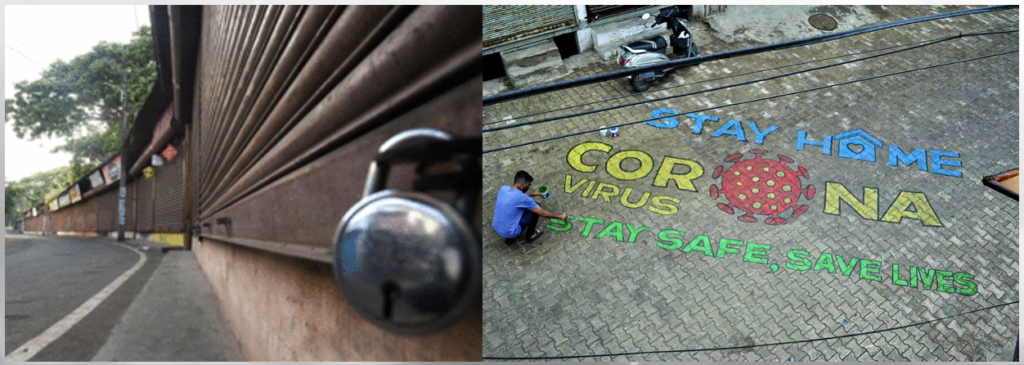Decoding a COVID Mutated Normal - Through the Consumer Behaviour Lens - Part 1.


This was on 5th of March 2020. The trip to Delhi was a quick morning/evening one. There was an important meeting – one I couldn’t miss at any cost.
Both, T2 in Mumbai & T3 in Delhi had a rather tentative atmosphere about them. International passengers were being screened for the novel Coronavirus and it was clearly a foreign thing, then. Post lunch in Gurgaon, met up with an industry colleague and then with a school friend of mine at DLF CyberHub. Had a quick and early dinner with him and then, as the heavens opened up, beat a hasty retreat to T3 for my flight back to Mumbai. Little did I know that it will be my last flight for a while! On 9th March, Pune gained the dubious distinction of opening the “confirmed cases” account in Maharashtra with a Dubai returned couple testing positive. In less than a week – 11th March to be precise – even as 2 folks in Mumbai (linked to the Pune couple) added to the tally, the WHO labelled COVID-19, a global pandemic. Unknown to all of us then, some words were going to be part of our normal vocabulary – forever.
And on 25th March, began the country-wide lockdown that was not only unprecedented but also one that changed forever our way of working. WFH – work from home – became the buzz word as organisations scrambled to put in place the infrastructure and human capital needed to make the transition as seamless as possible. Work from home and Stay at home – both have impacted businesses and consumer behaviour in more ways than one. Here, I attempt to decode what happened during the lockdown and my perspective on how consumer behaviour will shape up in the short and near term across a few retail categories. Be warned though, this is no fancy statistical and complicated analysis, rather is a set of musings of a mind that has been a keen student of customer behaviour for a little under25 years. In this first part, I will be focussing on a few categories that had a cardiac rhythm – howsoever feeble – during the lockdown.
FRUITS & VEGETABLES
Amongst the most essential of items (along with grocery & medicines), F&V has been the most active category. Unlike grocery, however, there is a limit to carrying inventory at home given the fact that they are perishable & freshness is important.
During Lockdown (DL) – For the initial few days, the friendly neighbourhood veggie vendor was the hero. Then, as stay at home got enforced, online delivery (both e-commerce players as well as aggregators) shone like the proverbial beacon in a nasty storm and the delivery messiahs on two-wheelers became the most awaited folks. A few more days into the lockdown, with increased curbs and RWAs realizing managing bulk deliveries reduce the possibility of infections, fresh-from-farm (FFF) options started sprouting up delivering on two objectives – (a) consumers getting “organic” fruits and vegetables fresh from the farms and (b) support-the-farmer cause as this helped in liquidating farmers’ inventory at more than fair price as compared to the APMC route.
Post Lockdown (PL) – In the near and short term, things will get back to pre-COVID days with the dependence on the neighbourhood bajji-wala, organized retail stores and e-commerce F&V players, being reinforced. I, however, also feel that the FFF momentum might just get retained as people are (forced to) getting conscious of what they are eating. These FFF entities will, however, need to automate their processes and adopt a 100% digital transaction DNA to earn mind and wallet share.
Impact – The role of cash has drastically reduced and folks across age groups are now adept at digital payments. The vendors have also stepped up dramatically in this aspect. Digital payments are here to stay – and grow – across all categories. Post lockdown, consumption levels could remain the same as lockdown levels.
GROCERY
The most hoarded category during the pandemic, grocery is where the pendulum swung between the taken-for-granted kiranas and large retail chain brands.
During Lockdown (DL) – In the initial days of the lockdown, the omnipresent kiranas became the darling of the masses with folks even taking emotional pledges that they would never ever buy from the “evil”, large guys with air-conditioning and fancy billing systems! In a certain sense, this pandemic brought to fore the importance of the more than 12 million kirana stores that dot this large country. A few large CPG brands and the government machinery have pledged to work with these kiranas and get them to a more organized level in terms of the store upkeep, inventory management and billing systems. Hope this does not remain another flash in the pan. But as lockdown progressed and supply chain hiccups got managed, organized grocery majors like DMart, Reliance and the likes, gained momentum. What was new was the growing popularity of pop-up attempts of brands like DMart in large residential complexes/areas as well as limited-SKU vending machines. E-Commerce entities faltered on this front due to supply inconsistency and delivery infidelity.
Post Lockdown (PL) – Consumer-grade hoarding will continue for at least a quarter if not more. The big guys will rule the roost again – purely for their merchandise breadth and the fact that they do carry larger pack sizes as well. Consumer confidence in a brand’s ability (and commitment) to put in and execute on processes that make shopping safer for them, will be a primary factor.
Impact – SOPs will change across the board with the focus purely being on delivering a safe shopping experience and maintaining “safe” inventory. “Contactless” payments and checkouts will be the preferred route. Every brand/store might have to adopt a “safety rating” system to enable that critical customer confidence. E-commerce buying will be on the upswing as well. Post lockdown, consumption levels could exceed lockdown levels with consumer access to a wider merchandise mix.
MEDICINES/PHARMACY
Yet another one in the essential category, medicine/pharmacy outlets – both online and physical – never saw closure.
During Lockdown (DL) – The categories in focus, apart from the normal medicines, have been the ones in the personal protect category – sanitizers, masks and gloves – and immunity boosters. Additionally, panic prompted hoarding of sanitizers in the initial periods leading to a veritable OOS situation across the board. Both online and physical formats thrived during the lockdown. The single biggest challenge faced was around deliveries to consumers. Supply chain was impacted heavily, and availability of prescribed drugs was/is a perennial problem. A positive of this has been the stepping up of dialogue between pharmacy/industry bodies and government regulatory bodies with a specific focus on generics. This period saw an upswing in digital consultations as well.
Post Lockdown (PL) – Probably, the sector with the least differential impact following the lockdown, things will remain as they were. The demand for personal protect items will continue for the next 2 quarters at the minimum. I sense a huge upswing in the immunity and wellness sub-category as well.
Impact – The digital makeover of this category could well be on the fast track subject to regulatory boundary conditions. Increased popularity of digital consultations resulting in cross-border collaboration (as some platforms do currently) could be a likely positive outcome of the pandemic. The focus on the importance of generics and evolving a strategy around this is a distinct possibility. Post lockdown, consumption levels could remain the same as lockdown levels – could increase in the immunity boosters’ sub-category, though.
FOOD & BEVERAGES
An essential category right from Day 1, F&B has had a roller coaster ride.
During Lockdown (DL) – While restaurants and all F&B related physical spaces were shut from the date lockdown was effected, deliveries for a major part of the lockdown and backed up by take-aways in the last couple of weeks, have been a minor saving grace. Understandably, this sector – from the road-side pani-puri walas to gourmet chains – all have been impacted deeply. Specialty F&B (Pizzas, Burgers, Biryanis, Cafes, Patisseries) managed to keep a small part of the kitchen running while the rest have had the shutters down. “Contactless Deliveries” was the order of the day.
Post Lockdown (PL) – Home food fatigue factor has set in! People would want to take a break from relentlessly preparing food (prolonged absence of cooks/helps) and consuming a limited range of food over 2 months! Though, people will be very cautious and will trust brands who message “unconditional safety” well. Brands have an edge here while the smaller players would have to work hard on earning their patron’s trust. Takeaways and deliveries will increase post the lockdown and people will tentatively return to physical spaces that will be appropriately “socially distanced”. (I keep wondering, why is it called “social distancing”? Should it not have been “physical distancing”? Well, that’s a discussion for another day!). Contactless deliveries will continue to be the norm.
Impact – Contactless deliveries aided by digital ordering and payment options will be the normal for this category. There will be efforts to have dine-ins as contactless as possible. Transparent and live kitchens could calm nerves better. Deliveries could include secondary or tertiary packaging (tear away and dispose off the packaging immediately on accepting delivery) to instil better consumer confidence. Will organized, regulator-approved food trucks aligned to the highest standards of hygiene be the showstopper in this category? A few of my industry colleagues do believe so! Additionally, there could be an overall safety related star rating that could apply to the restaurants – the aggregators are already enforcing this. Post lockdown, consumption levels could exceed lockdown levels thanks to the home-food fatigue factor.
This brings me to the end of Part 1 wherein I essentially looked at retail categories that were alive and breathing in some form or the other during the lockdown. I would keenly look forward to your comments/observations/critiques! In my next, I will focus on retail categories that had a completely flat, zero-sales line, namely CDIT, Apparel & Footwear, Sports & Fitness, Beauty & Wellness, Entertainment (though OTT was alive & thriving this lockdown) & Home Solutions/Improvement. Thanks for reading!
#retailstrategy #omnichannelretail #futureofretail #retailexperience #consumer #retailinnovation #retailtransformation #consumerbehaviour
You can read Part 2 of this series ( focussed on CDIT, Apparel & Footwear, Beauty & Wellness, Home Solutions & Home Improvement, Sports & Fitness & Movies and Entertainment) here – https://www.linkedin.com/pulse/decoding-covid-mutated-normal-through-consumer-lens-siju-narayan-1e/
